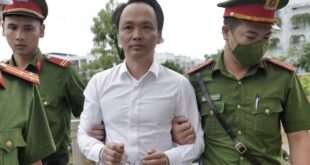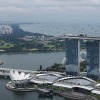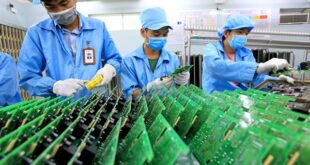.jpg)
|
| Jose Fernandez, United States Under Secretary for Under Secretary for Economic Growth, Energy, and the Environment. — VNS Photo Trọng Kiên |
HÀ NỘI — Shortage of qualified workforce and a proper regulatory framework for setting up renewable energy systems for use in semiconductor supply chains has been among the chief concerns of United States’ companies wanting to invest in Việt Nam in this “industry of the future.”
Jose Fernandez, United States Under Secretary for Economic Growth, Energy, and the Environment, made the statement as he was on a visit to Việt Nam to advance the implementation of the joint statement on upgrading Việt Nam-US ties to Comprehensive Strategic Partnership signed by US President Joe Biden and the General Secretary of Communist Party of Việt Nam Central Committee Nguyễn Phú Trọng in September 2023, with focuses on semiconductor, clean energy, and critical minerals.
With regards to semiconductor, the official highlighted the 2022 Act ‘Creating Helpful Incentives to Produce Semiconductors and Science’ (CHIPS Act) worth US$280 billion, “which provides not only for semiconductor manufacturing in the US but also provides for our ability to support countries as they try to create an international semiconductor value chain.”
He stressed the need to diversify the supply chains, adding that Việt Nam is one of the seven countries around the world that has received the funding from the International Technology Security and Innovation (ITSI) Fund (established under CHIPS Act).
The US will help Việt Nam in developing semiconductor workforce, improving investment environment for the semiconductor industry, which are among the hardest, biggest constraints that companies face as they try and expand their semiconductor supply chains, according to Fernandez.
“The US will work with Việt Nam in supporting Vietnamese schools to have over 50,000 engineers in this field in the next few years. That’s important for Việt Nam’s development of a semiconductor industry.”
“There are companies right now that are telling us that they want to invest in Việt Nam, but they’re having trouble finding the qualified workforce, and this is not just limited to Việt Nam. In the US, we have the same issue. We have companies that have said we are ready to invest. We have the funding, but we can’t find the qualified workforce. We will work with Việt Nam on the improvement of their workforce.”
In the next 1-2 months, there will be recommendations from the Organisation for Economic Co-operation and Development (OECD) with regards to improving the semiconductor workforce in Việt Nam, according to the US official.
The under secretary stated that there are 15 semiconductor companies who have said they are prepared to invest as much as $8 billion semiconductors in Việt Nam, however, he did not mention the specific names of the interested parties.
He also relayed the US businesses’ concerns on renewable energies to Vietnamese Prime Minister Phạm Minh Chính during their talks, with one of them being renewable energy.
“Many companies have made commitments to the shareholders and to their customers that they will use only renewable energy, so they are waiting for renewable energy regime and Việt Nam to expand. They’re waiting for permits so that they can establish renewable power systems here in Việt Nam.”
He remarked this was an opportunity to do two things at the same time, both of which would benefit the people of Việt Nam, which is spurring semiconductor development and turning climate change vulnerability into their favour.
Referring to the talks with Minister of Planning and Investment Nguyễn Chí Dũng where the Vietnamese side asks for not only the US Government’s support in semiconductor issues but also the backing of US companies, Fernandez noted that while the US Government could not “tell the companies what to do, where to go, but what we can do is to work with Việt Nam, with the Government, to improve its business environment, to improve its regulations on energy, to allow additional companies to come into Việt Nam to improve their energy security.”
He believes Việt Nam has a lot of advantages – a young qualified workforce i.e. “demographic dividends”, a large domestic market of 100 million people, and an exporting culture – all of which align with the US in its goal diversifying its supply chains.
“So Việt Nam could benefit from this. It’s a good opportunity to take advantage of. We can’t order companies to go anywhere, but we can also talk to them about the benefits. These are companies that have options, which is why one of my messages to my colleagues here in Việt Nam has been that ‘Seize the moment, understand the urgency that there’s a competition out there. We believe that Việt Nam and Vietnamese people could benefit from winning several of these competitions,'” the US Under Secretary of State stressed.
He also reaffirmed that the US was committed to supporting a strong, independent, resilient, and prosperous Việt Nam.
“Việt Nam is right now one of our largest trading partners, eighth largest. We are the largest export market for Việt Nam. Việt Nam is our ninth largest agricultural market. But it is not only about economics, it’s also about people-to-people ties. And something that I was struck by is the fact that Việt Nam right now is the fifth largest country in terms of foreign students in the US.”
He reiterated that trade with Việt Nam “has never been better”, with bilateral trade reaching nearly $140 billion and annual growth for the last 20 years hitting nearly 24 per cent. — VNS
- Reduce Hair Loss with PURA D’OR Gold Label Shampoo
- Castor Oil Has Made a “Huge” Difference With Hair and Brow Growth
- Excessive hair loss in men: Signs of illness that cannot be subjective
- Dịch Vụ SEO Website ở Los Angeles, CA: đưa trang web doanh nghiệp bạn lên top Google
- Nails Salon Sierra Madre
 VnExpress News The News Gateway of Vietnam
VnExpress News The News Gateway of Vietnam





